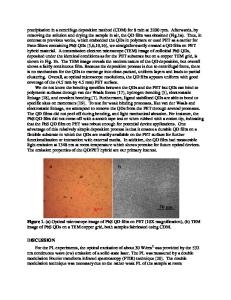Characterization of polyaniline thin films prepared on polyethylene terephthalate substrate
- PDF / 2,207,582 Bytes
- 15 Pages / 439.37 x 666.142 pts Page_size
- 74 Downloads / 385 Views
Characterization of polyaniline thin films prepared on polyethylene terephthalate substrate Yuliia A. Stetsiv1 · Mykhailo M. Yatsyshyn1 · Dmytro Nykypanchuk2 · Sergii A. Korniy3 · Ivan Saldan1 · Oleksandr V. Reshetnyak1 · Tamara J. Bednarchuk4 Received: 8 May 2020 / Revised: 5 September 2020 / Accepted: 13 October 2020 © Springer-Verlag GmbH Germany, part of Springer Nature 2020
Abstract The polyaniline thin films were prepared by in situ chemical polymerization of aniline on polyethylene terephthalate substrate in the aqueous solutions of citric acid with ammonium peroxydisulfate as oxidant. Using ultraviolet–visible and Fourier transform infrared spectroscopy, X-ray diffraction, scanning electron with energydispersive X-ray microscopy, atomic force microscopy, and four-point probe resistivity measurements, pure polyethylene terephthalate and polyaniline thin films were thoroughly characterized. Chemical analysis confirmed the formation of polyaniline with a high degree of oxidation in the form of a smooth thin film (with a thickness of ~ 80 ± 10 nm) on polyethylene terephthalate surface. However, delocalized polyaniline macromolecule aggregates in the spherical shape (with the diameter of ~ 30–40 nm) as well as in the irregular shape (the maximum size of ~ 300 nm) were found on the substrate. The values of average arithmetic roughness, average square roughness, asymmetry, kurtosis, average maximal profile height as well as average maximal height, and depth of roughness were calculated based on the atomic force microscopy data for pure polyethylene terephthalate and polyaniline thin films. Keywords Polyaniline · Polyethylene terephthalate · XRD · UV–Vis · FTIR · AFM · SEM–EDX
Electronic supplementary material The online version of this article (https://doi.org/10.1007/s0028 9-020-03426-7) contains supplementary material, which is available to authorized users. * Ivan Saldan [email protected] Extended author information available on the last page of the article
13
Vol.:(0123456789)
Polymer Bulletin
Introduction Among all electrically conductive polymers, polyaniline (PAn), in the number of scientific papers devoted to the study of its synthesis, properties, and applications, is being actively researched [1]. A huge variety of synthesis methods, high electronic conductivity and stability in air and water as well as many other unique physical and chemical properties make PAn an important material in modern nanotechnologies [2–4]. High interest in studying PAn is due to its simple production and ability to alter chemical and physical properties through changes in conformational isomerism, material design, and morphology. These features suggest a wide application of PAn. However, in addition to a number of advantages, PAn also has some drawbacks, which are poor mechanical stability and high brittleness [5]. In order to meet the technological requirements for PAn, it might be prepared in the form of a film on a solid substrate [6]. The synthesis of PAn thin film on an electrically nonconductive sub
Data Loading...










